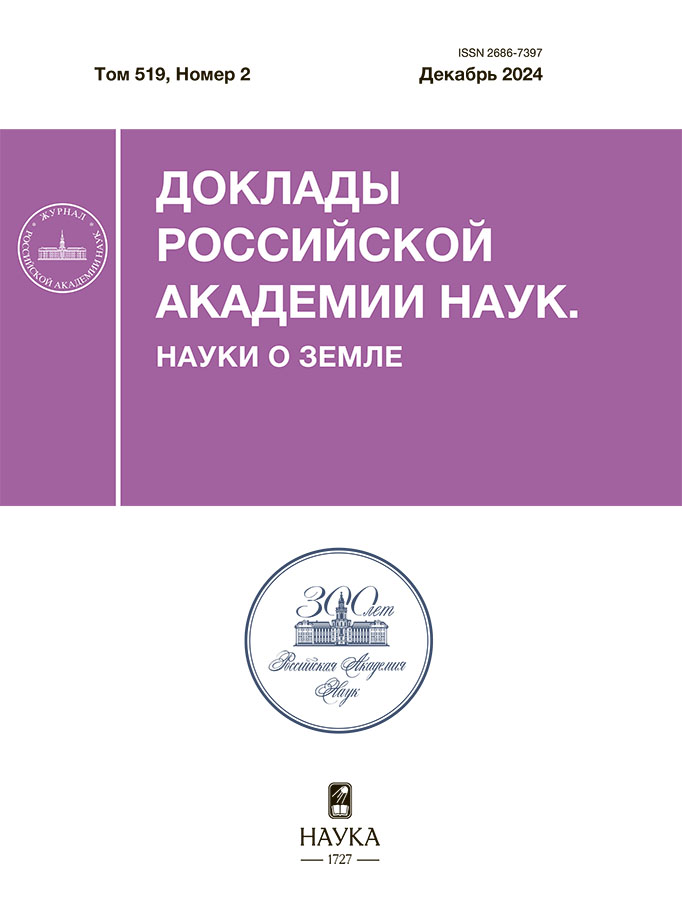Sm–Nd AGE of the Kolvitsa Fe–Ti–V deposit, Porya Guba clinopyroxenite-wehrlite Complex, Kola region
- Autores: Serov P.A.1, Groshev N.Y.1
-
Afiliações:
- Kola Science Center of the Russian Academy of Sciences
- Edição: Volume 519, Nº 2 (2024)
- Páginas: 41-48
- Seção: GEOLOGY OF ORE DEPOSITS
- ##submission.dateSubmitted##: 04.06.2025
- ##submission.datePublished##: 28.12.2024
- URL: https://vestnik.nvsu.ru/2686-7397/article/view/682447
- DOI: https://doi.org/10.31857/S2686739724120052
- ID: 682447
Citar
Texto integral
Resumo
The isotopic age of rocks from the clinopyroxenite-wehrlite Porya Guba Complex hosting the Kolvitsa Fe-Ti-V deposit was determined for the first time. Sm–Nd age of the barren clinopyroxenites prevailing in a studied massif is 1858 ± 34 Ma (εNd(T) = –1.5) and is considered as the emplacement time of the Porya Guba Complex, occurred after the peak of granulite metamorphism (1925–1915 Ma). Quenching zones found around xenoliths of granulites in clinopyroxenites indicate the emplacement of the complex into the cooled rocks of the Lapland-Kola orogen, which is consistent with the estimated time of its cooling (1880–1870 Ma, 450°, by rutile). Mineralized rocks, as inferred from active assimilation of granulite xenoliths, are formed at a late stage of the complex development: the age of mineralized pyroxenites enriched in platinum and palladium (0.8 g/t) is 1832±35 Ma (εNd(T) = –2.0), while the age of titanomagnetite ore is 1823 ± 19 Ma (εNd(T) = –2.5). Thus, the obtained isotopic data indicate that the emplacement of small ultramafic intrusions developed in the Kandalaksha-Kolvitsa granulites (Kolvitsa Melange) took place during the cooling stage of the Lapland-Kola orogen.
Texto integral
Sobre autores
P. Serov
Kola Science Center of the Russian Academy of Sciences
Autor responsável pela correspondência
Email: p.serov@ksc.ru
Geological Institute
Rússia, ApatityN. Groshev
Kola Science Center of the Russian Academy of Sciences
Email: p.serov@ksc.ru
Geological Institute
Rússia, ApatityBibliografia
- Балаганский В. В., Горбунов И. А., Мудрук С. В. Палеопротерозойские Лапландско-Кольский и Свекофеннский орогены (Балтийский щит) // Вестник Кольского научного центра РАН. 2016. № 3 (26). С. 5–11.
- Glebovitsky V., Marker M., Alexejev N., Bridgwater D., Sedova I., Salnikova E., Berezhnaya N. Age, evolution and regional setting of the Palaeoproterozoic Umba igneous suite in the Kolvitsa–Umba zone, Kola Peninsula: constraints from new geological, geochemical and U–Pb zircon data // Precambrian Res. 2001. V. 105. P. 247–267.
- Балаганский В. В., Басалаев А. А., Беляев О. А., Пожиленко В. И., Радченко А. Т., Радченко М. К. Геологическая карта Кольского региона (северо-восточная часть Балтийского щита) масштаба 1:500000 / Гл. ред. Ф.П.Митрофанов. Апатиты, 1996.
- Бибикова Е. В., Мельников В. Ф., Авакян К. Х. Лапландские гранулиты: петрология, геохимия и изотопный возраст // Петрология. 1993. Т. 1. № 2. С. 215–234.
- Каулина Т. В. Заключительные стадии метаморфической эволюции Колвицкого пояса и Умбинского блока (юго-восточная ветвь Лапландского гранулитового пояса): U–Pb датирование циркона, титанита, рутила // Вестник Мурманского государственного технического университета. 2009. Т. 12. №. 3. С. 386–393.
- Чащин В. В., Баянова Т. Б. Петро-геохимия и U–Pb возраст интрузии Плотичья Варака, Кольский регион // Труды Ферсмановской научной сессии ГИ КНЦ РАН. 2023. Т. 20. С. 222–228.
- Войтеховский Ю. Л., Нерадовский Ю. Н., Гришин Н. Н., Ракитина Е. Ю., Касиков А. Г. Колвицкое месторождение (геология, вещественный состав руд) // Вестник МГТУ. 2014. Т. 17. № 2. С. 271–278.
- Нерадовский Ю. Н., Грошев Н. Ю., Войтеховский Ю. Л., Бороздина С. В., Савченко Е. Э. Минералы платины, палладия, серебра и золота в Порьереченском титаноносном комплексе (Кольский полуостров) // Вестник КНЦ. 2017. № 3. С. 77–94.
- Беляев К. Д., Карпов Р. В. Геологические предпосылки поисковых работ на Кольском полуострове и новые направления их развития. Состояние и перспективы расширения минерально-сырьевой базы Северо-Запада РСФСР. Л.: Недра, 1973. Лен. Отд. C. 15–29.
- Лимберис Ю. Г., Чемисов Г. К., Смирнов Ю. П. и др. Сводный отчет о результатах поисковых работ на Ni, выполненных в Терском районе в 1966–1969 гг. Апатиты: ФГУ МурТФГИ, 1970. 165 c.
- Шолохнев В. В., Васильева В. А., Кузнецов В. А., Клюев Н. К., Докучаева В. С., Богачев В. А., Кнауф В. В. и др. Оценка платиноносности крупных расслоенных массивов Карело-Кольского региона / Отчет: в 4 кн. СПб.: Фонды ВСЕГЕИ, 2007. 358 с.
- Tanaka T., Togashi S., Kamioka H., Amakawa H., Kagami H., Hamamoto T., Yuhara M., Orihashi Y., Yoneda S., Shimizu H. JNdi-1: A neodymium isotopic reference in consistency with LaJolla neodymium // Chem. Geol. 2000. V. 168. P. 279–281.
- Serov P. A., Bayanova T. B. The Sulfide/Silicate Coefficients of Nd and Sm: Geochemical “Fingerprints” for the Syn- and Epigenetic Cu-Ni-(PGE) Ores in the NE Fennoscandian Shield // Minerals. 2021. V. 11. 1069.
- Bouvier A., Vervoort J. D., Patchett P. J. The Lu–Hf and Sm–Nd isotopic composition of CHUR: Constraints from unequilibrated chondrites and implications for the bulk composition of terrestrial planets // Earth Planet. Sci. Lett. 2008. V. 273 (1–2). P. 48–57.
- Goldstein S. J., Jacobsen S. B. Nd and Sr isotopic systematics of river water suspended material implications for crystal evolution // Earth Planet. Sci. Lett. 1988. V. 87. P. 249–265.
- Villa I. M., Holden N. E., Possolo A., Ickert R. B., Hibbert D. B., Renne P. R. IUPAC-IUGS recommendation on the half-lives of 147Sm and 146Sm // Geochim. Cosmochim. Acta. 2020. V. 285. P. 70–77.
- Vermeesch P. IsoplotR: A free and open toolbox for geochronology // Geosci. Front. 2018. V. 9. P. 1479–1493.
- Чащин В. В. Райненчоррский клинопироксенитверлитовый комплекс // Расслоенные интрузии Мончегорского рудного района. Ч. 1. Апатиты: Кольский НЦ РАН, 2004. С. 133–153.
Arquivos suplementares













